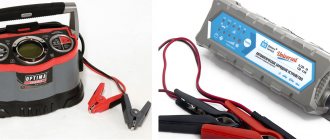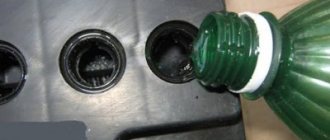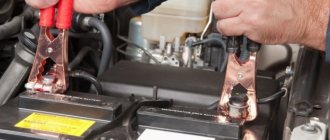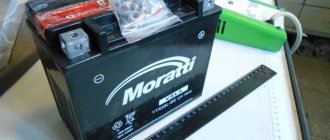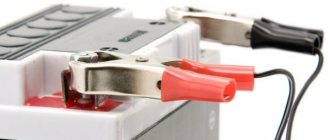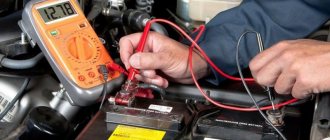Cars admin26.02.2020
When it comes to means of transportation, each of us has our own tastes and preferences. Some people prefer passenger cars, and here, too, interests differ, since there are a considerable number of types of bodies. There are connoisseurs who find large SUVs attractive. But there is a category of people who value scooters. There are many advantages to be found in these small vehicles, and they will delight their owners. At least until the gel battery fails. How to restore it later is an interesting question, and this article is dedicated to it.
What is typical is that the number of people wishing to switch to two-wheeled transport is only increasing from year to year. And if compared with a moped or motorcycle, they are inferior to scooters in understandable advantages. Well, there’s no point in making any comparisons with a bicycle.
What kind of strange animal is this?
Today, a gel battery can be found in almost any store that sells spare parts for various types of vehicles. However, not everyone is aware of the issue of its design, since in appearance such batteries are practically no different from their acid counterparts.
Some time ago, lead acid batteries, into which liquid electrolyte was poured, were very popular. However, progress does not stand still, and now acid batteries have already lost their former glory, which has passed to their more advanced competitors. Nevertheless, there are also difficulties with them, and then the first question is: “Can gel batteries be restored?” More on this later.
Initially, batteries made using this technology were created for military equipment, in particular aviation. Conventional devices did not cope with their task because they were subjected to constant overloads, which negatively affected the acid electrolyte. And as a result, the battery will quickly fail without the possibility of recovery. It is for this reason that gel analogues appeared.
AGM battery technology
AGM stands for Absorbent Glass Mat and means “absorbent glass fiber”. In fact, these are ordinary lead-acid batteries, only in them the electrolyte is not in the form of a freely flowing liquid, but in the form of glass wool abundantly soaked in a solution of sulfuric acid (a kind of diaper for electrolyte). What does it give:
- There is a place for the hydrogen released during the charging process - it is “locked” in the fiberglass. In other words, the gas is completely recombined inside the battery. This allows you to safely use AGM batteries indoors.
- Sealed design allows them to be used in any position
- They do not require maintenance, but this does not eliminate the need for periodic “training” of batteries
Especially for our readers, we did not regret and sawed up the popular CSB GP 12120 battery, let's see what's inside:
Cutting CSB GP 12120
Lead plates with absorbed glass wool electrolyte
AGM itself is richly impregnated with electrolyte
Advantages of a gel battery
You could go on for a very long time listing all the advantages of scooters over other vehicles, but this is not included in the topic under consideration. It is better to evaluate the advantages that a gel battery has.
In conventional power supplies, the chemical reactions of the electrolyte proceed quite violently with the release of vapors, and sometimes it simply boils. Acid batteries often exploded during operation. Will the gel battery suffer the same fate and how can I restore it later? Most likely not, since here lies the main difference and superiority of this power source. It uses an electrolyte of special viscosity, reminiscent of jelly in consistency. And again the question: “How to restore a gel battery?”
Thanks to the addition of a thickener, the battery can be used in almost any position. But, as practice shows, its effectiveness in a position on its side drops by a third, and turning it over is generally not recommended.
Other advantages include the following:
- repeated charge-discharge cycle;
- there is no need to initially charge gel batteries immediately after purchase;
- at maximum discharge, capacitive characteristics are not lost;
- high starting current;
- low loss of capacity during long periods of inactivity compared to acid devices;
- long service life.
It is also worth noting that if the case is damaged, this will in no way affect the performance of the battery. And in this case you won’t have to think about how to restore the gel battery. But for lead devices, this defect is dangerous because electrolyte leakage may occur. In gel ones, the latter is not in a liquid state, and therefore there can be no talk of any leakage.
In addition, modern analogues are recognized not only as high-tech, but also as the safest. As for the service life, theoretically it is up to 10 years. But, as practice shows, rarely does any specimen live that long.
Fundamental differences between gel batteries
Gel batteries, related to chemical lead-acid direct current sources, differ in the aggregate state of the electrolyte. The working fluid consists of a mixture of sulfuric acid and distilled water with the addition of a silicone thickener.
The solution, which has the consistency of thick jelly, fills the gaps between the negative and positive electrodes, increasing the energy capacity and strength of the structure. The thick solution ensures that the gases generated during battery operation are retained, which are then recombined during chemical reactions.
To retain the gel, a separator made of porous plastic is used. The material ensures the preservation of strength characteristics under heating or mechanical loads. The separator helps maintain a stable gap between the plates and eliminates the possibility of a short circuit.
To improve the contact of the thick electrolyte with the positive plate, an additional fiberglass gasket (0.3-0.4 mm thick) is used.
An alloy of lead and calcium with the addition of tin is used to make positive and negative plates. The material ensures an increase in battery life and maintains a stable starting current. A gel battery allows several hundred discharge and charge cycles without losing the initial capacity characteristics.
Another difference between gel power sources is the ability to work when the body is tilted. Thick electrolyte does not flow out of the gap between the plates even when the housing is rotated at an angle of more than 90°.
Gel-filled batteries allow deep discharge when connecting energy-intensive external equipment. The design of the device allows recovery from a deep discharge state. There is no need to connect an external power source immediately after the battery is discharged.
Deep discharging a partially charged battery does not negatively affect the capacity of the device. The thick electrolyte ensures low self-discharge of the battery, further increasing the service life of the product.
Disadvantages of a gel battery
Unfortunately, with all the obvious advantages, gel batteries are not without some disadvantages:
- high sensitivity to charge voltage;
- gel batteries do not tolerate short circuits in the electrical circuit;
- price.
Despite the fact that they are highly resistant to frost and some mechanical damage, they must be charged correctly. To do this, use only devices specifically designed for gel batteries. Otherwise, damage to the gel battery cannot be avoided, and the question of how to restore it will disappear by itself. Because there will be nothing to restore.
The charging voltage should not exceed 14.2-14.4 V, otherwise loss of performance is guaranteed. But there are no current restrictions, since such batteries have low internal resistance.
Can modern gel batteries fail? It is quite possible. If, for example, you completely discharge the battery and leave it in this state for a long period, then later, if necessary, it is unlikely to want to be charged. Therefore, it is better to charge the battery in a timely manner. Also, do not use car devices for charging.
Fortunately, the gel battery has few disadvantages. However, in our world there is still no such object or device that would be completely devoid of all disadvantages and would contain only advantages. Such an ideal! Although, maybe it’s just a matter of time?!
How to restore a gel battery: DIY repair
In gel (not helium) batteries there is no gas - helium; in them the electrolyte is bound by a solid material and thickened, that is, it is in a gel state. Therefore, without fear of depressurization, a maintenance-free battery can be opened if it is impossible to charge it and the voltage on it drops below 10 V.
The first is pouring distilled water into the battery jars
Although gel batteries are also called dry batteries, they must contain a water-based electrolyte inside them. And water in gel, and especially in acid, batteries is a consumable material, since when it is reduced by electrolysis of lead sulfate deposits on the plates, it is destroyed into the hydroxyl group and hydrogen. The latter leaves any battery into the surrounding air. In gel batteries, hydrogen escapes through rubber valve caps located under the outer plastic cover, which is often covered. Therefore, distilled water must be added to a very dry gel battery that has lost capacity.
To service a “maintenance-free” battery, you will need to tear off the glued top cover and remove all valve caps. You need to add a little water - not to the edges of the filler necks on the jars. The poured water will be absorbed into the filter paper, so after half an hour, look (by shining a flashlight) to see how much water is left in each section of the battery. The water level should slightly cover the surface of the battery plates, so excess liquid will have to be removed with a syringe or rubber bulb.
Recovery by long-term charging
After moistening the dried electrolyte, close all battery jars with valve caps. And also do not forget to cover them with the outer battery cover, and press it down with a weight (glue it later). You need to press down on the lid so that it holds the rubber caps. When charging, excess pressure created by the released hydrogen will be released through the caps, and the lid will act as a stop for them.
Now it's time to connect the damaged gel battery to the charger. Learn how to charge a maintenance-free battery. Having lost capacity due to drying of the bound electrolyte, the battery will not consume current from the charger, so there is no need to first rely on the ammeter. The charging voltage must be at least 15 V.
It will take a long time to charge - until the starved battery begins to consume current. But if more than 15 hours have passed and the battery does not consume current, then do not expect a miracle, but increase the voltage to 20 V. Now do not leave a battery charging at high voltage unattended. After all, if the bound electrolyte is restored, then an abnormally high current will flow through the battery, which will be 4–6 times higher than expected. A current even 4 times greater than the maximum permissible 0.1 of the capacity will heat up the battery, then smoke will come out of it, and then...
The moment the battery begins to accept current, the voltage across it will begin to drop quickly.
Cyclic charging
A good way to “rock” a battery that doesn’t want to charge is to first let the battery charge and then discharge it – and so on alternately, in short periods. The first charging cycles, specifically for a gel battery, should occur at high voltage - about 30 V, and in subsequent cycles the charging voltage should be gradually reduced to 14 V.
You need to discharge a recharged battery with a very small load - a 5 or 10 W light bulb, and not a car carrier with 50, 75 or 100 W light bulbs. But even when unloading the battery using a small light bulb, monitor the voltage on the battery so that it does not drop below 10.5 V.
After you have managed to force the “emaciated” battery to swallow current, continue to restore it to full charge by long-term charging with a low current - equal to 0.05 of the battery capacity.
The restoration of acid batteries follows a completely different algorithm.
Author: Vitaly Petrovich, Ukraine, Lisichansk.
volt-index.ru
Recovery issues
As practice shows, the first problems arise after 4 years of use. Loss of electrical capacity or boiling away of water from the electrolyte are some of the most common symptoms that a gel battery suffers from. How to restore it is the first thing that comes to the owner’s mind. Despite the fact that this type of battery is a maintenance-free device and cannot be resuscitated, you can still try to do it.
During operation, over time, the gel-like electrolyte begins to dry out, even in the presence of such a phenomenon as gas recombination. The whole point of the restoration process is to add water, as is done with acid batteries. But with a gel battery, everything is not as simple as it seems, because it is more capricious.
mission Impossible
Unfortunately, or maybe, on the contrary, fortunately, there are times when it is not possible to restore a gel battery. One of these irreversible faults is when the electrolyte begins to peel off from the plates.
Or they may begin to break down. If this happens, then this also negates all attempts to revive the product. It is not difficult to detect such a malfunction - just shake the battery, and you can hear a noise coming from inside. The presence of a crack is also an unpleasant sign. How to restore a gel battery (12V) if available? The answer is simple: no way.
"Cunning manufacturer" of gel battery
It’s worth starting with the fact that absolutely all manufacturers of gel batteries categorically prohibit users from restoring their products. Moreover, they do everything to make it impossible to do this.
Look at a typical gel battery. The cunning manufacturer sealed the plugs so that you can’t pick them out, and made the case non-separable, and even left the holes for refilling the battery so small that a curious user could not look into them. Some models don’t even have any plugs - a purely sealed body.
But does that stop our brother? The domestic user does not give up. He is convinced that the cunning manufacturer specifically makes its gel batteries so that they are impossible to restore. He wants the user to throw away the old battery and buy a new one from him.
Visual diagnostics
As a rule, it is worthwhile to restore the battery when the output voltage is less than 10 volts. First, you should carefully inspect the product for cracks or extraneous noise when shaken slightly. If the listed defects are found, the restoration stage is completed, since the problem can only be solved by purchasing a new battery.
If everything is in order (nothing rattles, no cracks), you should pay attention to the residual stress. If it is less than 30%, then the conclusion is also disappointing. You can try, but it’s like playing roulette - maybe you’ll get lucky, but it’s unlikely. It is good when the residual stress is close to 60%. In this case, you can proceed directly to solving the problem. So, how to restore a scooter's gel battery?
Water filling procedure
The water for the gel battery is not ordinary tap water, but distilled water. If you have questions about purchasing it, you can contact one of the pharmacies or a store that is popular among car enthusiasts. But it is best to buy distilled water at a pharmacy, since you can avoid counterfeiting.
Filling with water is done with a syringe, and there are several effective methods that are essentially the same:
- The method is as follows. Using a syringe, each jar is completely filled with water, after which you need to leave the battery for a while. 5-10 minutes is enough, after which all the water should be removed, using the same xs syringe. During this period, the electrolyte will absorb the required amount of water. In some cases, it is recommended to wait not 10 minutes, but half an hour. After the water has been drained, you can close the caps and charge the battery.
- The next way to restore a gel battery (12V, 7 Ah) is no less effective. You need to pour no more than 3 cubes of water into each of the cans, after which they are closed with caps, and the power source is put on charge.
- Fill the jars with water until the plates close, but at the same time you want the water to not reach the edges. Do not close the caps yet, as excess water and gas will escape. Now you can charge the battery, and at the end of the process you can close the jars with caps.
When installing the protective rubber bands in their place before charging (except for the last case), you need to fix them well.
Charging Features
When charging a gel battery, the main thing is to remember to supply a voltage of no more than 14.2-14.4 V, as mentioned above. Unless, of course, we want to get a product that is unusable. But you should pay attention to the current. Its value should be 10% of the battery capacity. For example, 7-amp products need to be charged with a current of 0.7 A.
In some cases, it is not always possible to decide how to restore a gel battery at home. Or rather, the result does not meet expectations. At first, when connecting the product to the charger, no current consumption will be observed, so the ammeter will not show anything. But after some time, the “hungry” battery will begin to take portion after portion. All that remains is to wait for the battery voltage to reach the desired value.
Methods for restoring a “live” gel battery
Actually, there are as many as two such methods, and they apply only to those batteries that have not lost their ability to consume current. We are by no means talking about a syringe and distilled water, which folk craftsmen use to try to “soak” the dried gel. Believe me, such actions will not give any useful results. Water can only save a battery with liquid electrolyte. In the case of gel, it will act as a dielectric, which will further aggravate the already deplorable condition of the battery.
Recovery method No. 1
Quite often there are cases when a gel battery refuses to work because it simply does not restore the wasted energy naturally - from a car generator or the charging circuit of an uninterruptible power supply device. In such cases, charging from a stationary device will help restore the battery.
It is necessary to charge with a current equal to 10% of the nominal capacity of the battery and a voltage of up to 14.4 V. The process should be stopped when, at the specified voltage, the current consumption drops to one tenth of an ampere.
Recovery method No. 2
Widely used by owners of traditional batteries with liquid electrolyte. Practice shows that for gel batteries this method is also relevant and quite effective. It's about training the battery.
The point is simple. The battery is charged to 100%, then discharged forcibly using the load. Afterwards the cycle is repeated two or three times.
There is another training algorithm, often embedded in programmable chargers. It consists in the fact that the battery is charged with a low current, and during the charging process it is periodically loaded with an ordinary incandescent light bulb.
All. Any other methods are not that ineffective. They are obviously dangerous and useless.
What can happen if you charge incorrectly?
A gel battery is a capricious “creation”, and if you apply a voltage of 15 or more volts, it will simply swell, since the battery is completely sealed. In addition, detachment of the electrolyte from the plates may occur. In some cases, gas is even released. Then how to restore a gel battery (6V) is out of the question.
Thanks to its good sealing, any room is suitable for charging the battery, the main thing is to prevent the voltage from increasing. You need to turn off the charger only after the battery is fully charged, not earlier. This is also very important!
Competent and illiterate restoration of a gel battery
The lyrical digression above was written for a reason. The answer to the question: how to restore a gel battery will be based on it. There are two ways to try to do this – literate and illiterate.
The border between these two methods is exactly where the manufacturer is trying by all possible methods to limit any user intervention in the “inner world” of the gel battery.
A competent user will never destroy the battery, as the manufacturer prohibits this. He will try to restore it correctly. And in order to restore a gel battery correctly, you must, first of all, be able to see the difference between a non-recoverable battery and a still living battery.
To summarize
As you can see, the whole process, although it takes a long time, does not contain anything complicated. And the answer to the pressing question will be the following: yes, you can restore a gel battery! True, this is not always possible.
Information site about energy storage devices
Gel batteries are operated under conditions that are far from ideal. Therefore, the statement that the gel does not release molecules from the mass, there is no evaporation, is not true. Why, then, are there rubber caps under the stoppers on each can? Over 2-4 years, depending on operating conditions, the gel will dry out and contact with the lead plates will weaken. At this point, the owner of the equipment will notice that there is not enough charge for the usual amount of work. Another reason for capacity loss is a long period: discharge-waiting for recharging.
How to return the capacity of a gel battery
Reconditioning gel batteries involves returning water to the electrolyte mass. In this case, a moderate amount of liquid is added, only to ensure complete contact. Excess moisture is harmful.
In maintenance-free batteries, there are plastic circles glued in flush on top of each can. You need to pick them out with a sharp object and remove the rubber plugs at the bottom. Pour 10 milliliters of pharmaceutical distilled water into each jar. The liquid should be absorbed into the gel within a few hours.
The battery must be fully charged before the operation. After dissolving the gel, carry out a resistive discharge and charge in the usual way.
When should you not recharge your battery?
If the body of the device is damaged, there is a crack or swelling, it is impossible to restore gel batteries. The deformation shows that the process of chemical destruction of the electrolyte was active. Perhaps the gel has undergone irreversible changes. Water will no longer restore the internal component composition.
The plates inside may collapse. Unusable cans in a gel battery are not changed. You can make sure that the plates have crumbled or settled by shaking the body. Characteristic sounds will be heard. You can shine a flashlight inside the suspicious cavity.
Cracks in the body or fistulas led to the removal of part of the active mass. By sealing them, you will not restore internal balance. If cracks occurred when the battery was frozen, the composition itself has already lost its properties.
Recovery of 7 amp gel battery
Such batteries are classified as traction batteries. That is, the storage device releases energy for a long time and evenly. He is not afraid of deep discharge. But the main use of 12 V 7 A gel battery is in motorcycles, scooters and boats. The battery is a maintenance-free model or with lids, consisting of 6 cans, with a total weight of about 2 kg. Products with clearly lighter weight have two pairs of linings in each can instead of three and a smaller capacity.
To restore the capacity of the gel battery, you need to open the lids, remove the rubber caps and add 1-2 cubic centimeters of distilled water to each jar. In this case, the battery must be fully charged. The liquid will allow the gel to swell and adhere more tightly to the plates after about 4 hours. Afterwards you need to check whether the battery will accept a charge. First, discharge the battery to a voltage of 10.5 V, then charge it again. According to the schedule, the first discharge should take 1 hour, charging 2, the next cycle 3 hours of charging and the same amount of discharge. If the capacity is restored, charge the gel battery to operating voltage. Battery maintenance is then normal.
The owner started the completely discharged gel battery by pushing the inverter, passing a current of 150 amperes for 20 seconds. But this extreme measure was carried out after unsuccessful attempts. The gel has been moistened. It was not possible to charge the battery within 6 hours. After using the welder, charging began. In 6 hours the voltage became 12.8, the scooter started up.
How to check a gel battery
Maintaining and checking a gel power supply consists of the following steps:
- Conduct a visual inspection of the housing for the appearance of swelling or cracks.
- Check the cavity of the cans; crumbling of the plates and electrolyte is not allowed.
- Measuring the voltage at the terminals at rest with a test device. Then a load plug is connected, simulating the operation of an engine starter or external load. The resistance is kept connected for 4-5 seconds, then the owner visually assesses the speed of restoration of the original voltage. A working battery shows voltage under load ranging from 11.5 to 12 V.
Video
See how to restore the capacity of a gel battery with your own hands.
Gel batteries are already quite widespread in household appliances today. Most often they can be found in uninterruptible power supplies (UPS), scooters, radios, and various portable devices. This type of battery lasts 3–4 years, and then problems begin with their operation due to severe loss of capacity. Gel batteries remain in charge-standby mode for a long time and for this reason their nominal capacity decreases. Another problem is boiling away of water from the electrolyte. Although they do not contain liquid electrolyte, the fiberglass on the lead plates must be kept moist. Gel batteries are mostly maintenance-free, but getting to the banks is realistic and not so difficult. Therefore, if problems begin with the battery, you can try to restore it.
Comparison: which battery is better, gel or AGM?
AGM batteries are distinguished by the presence of an electrolyte that is not liquid or gel - the acid solution fills the fiberglass, which is located between the plates. Due to the rather compact arrangement of the material, the dimensions of agm batteries can significantly increase the capacity of the power source. These batteries are characterized by low internal resistance, which allows us to talk about the fastest charging of the power source and rapid discharge due to the ability to deliver high currents. AGM batteries can withstand over 200 full discharges. The only rational reason to abandon gel batteries in favor of AGM may be the need for high starting currents to start the car in cold weather. In other parameters, AGM technologies are significantly inferior to gel ones.
In what cases is battery restoration inappropriate?
It should be noted right away that in most cases, failed gel batteries cannot be restored (swelling, destruction of plates, etc.). In such a situation, you shouldn’t bother with them and it’s easier to buy a new one.
- Bloating. Swelling of one or more jars indicates that the electrolyte gel has peeled off from the lead plates. This battery can no longer be restored and is heading straight to the landfill. Bloating can be determined visually;
- Destruction of plates. This often happens as a result of long-term operation of uninterruptible power supplies in a poorly ventilated place. As a result of prolonged exposure to elevated temperatures, the contents of the jars are destroyed, including the fiberglass, gel electrolyte and the plates themselves. In particularly advanced situations, only coal dust remains inside. To identify this problem, shake the gel battery and listen. If something is loose inside, then the battery belongs in a landfill. There is no use in restoring it. You can also shine a light and look inside the openings of the cans. If the plates are visually indistinguishable, then the battery has served its purpose.
In the photo below you can see gel batteries that cannot be restored:
Batteries that cannot be restored
Gel battery with broken plates
Is the gel recoverable?
Manufacturers do not recommend carrying out restoration work, since when a gel battery fails, irreversible destruction of the plates and case occurs. After the test, the owner can try to return the battery to its original parameters, but manipulations do not guarantee a positive result. To restore the device, the method of topping up with distilled water is used, followed by charging from an external power source.
For restoration work, gel-type batteries are selected that have a voltage at the contact pins ranging from 50 to 60% of the nominal parameter. If the voltage is reduced by 25-30%, then the power source can be restored to its original capacity. Products with reduced characteristics are partially restored.
How to restore a battery
Now directly about how to restore a gel battery. The gallery below shows the procedure. First, remove the top plastic cover. Then the rubber caps are removed from all cans.
Remove the plastic cover
Remove the rubber caps
The battery is ready to be filled with water
There are also varieties of gel batteries with individual caps over each can. You will have to remove them all and then remove the rubber caps.
Removing plastic covers
The battery is ready for restoration
Do not add a lot of distilled water. Moreover, the plates should not float in it. Water is required to return the gel electrolyte to its normal state and restore the battery. During operation, distilled water evaporates and as a result the gel dries out. It is better to pour a little water into 1-2 “cubes” and leave the battery for 2-3 hours.
The water will gradually be absorbed. Then add more if needed. It is enough just to keep the fiberglass with the gel moisturized. But nothing should float in the water. If there is water bubbling around in the jar, it needs to be pumped out with the same syringe.
Distilled water is easiest to measure and fill with a syringe.
Further recovery involves normal battery charging. Do not forget that the voltage should not exceed 14.4–14.6 volts, and the current is 0.1 of the battery capacity. If the battery is from a UPS, you can install it back and charge it in the case. To do this, simply connect it to the network and turn it on without load. It may happen that during the charging process the battery will accept current very poorly. If charging has been going on for several hours and the current is not perceived, you need to increase the voltage to 20 volts.
Attention! In this case, you will need to constantly monitor the charging process until the current flows. This will be visible by the voltage drop. It is important not to miss this moment, otherwise the gel battery will be damaged. I will say more, exceeding the current several times the permissible will cause smoke and burnout of the gel battery.
After the battery begins to accept current, set the voltage to about 14 volts. In this case, the current should not exceed 0.1 of the battery capacity. Then charge as usual and the battery will be restored. Return to content
How to restore a gel battery of a car and scooter
Despite the fact that gel batteries are formally classified as maintenance-free, and their service life is indicated by manufacturers at 10 years or even more, in reality everything looks somewhat different. In popular literature, it is not recommended to restore a gel battery if its capacity (Ah) drops sharply, or if it fails for any reason. However, among car enthusiasts there are ways to restore a gel battery with your own hands - at home, in the garage and, in fact, in any convenient place.
Is the “gel” recoverable?
Of course, not every battery can be restored: it happens that the battery case turns out to be damaged during its inspection. Or something inside it begins to “jingle” when you try to take it out of the car or move it to another place. If this happens, you should not attempt to restore visibly damaged batteries: this can be dangerous. In addition, you will then regret the wasted time that could have been spent on purchasing a new battery.
Therefore, before starting restoration, it is important to inspect the battery as thoroughly as possible and check it for remaining functionality in order to determine whether it is worth taking on.
You can determine whether a gel battery for a car is “alive” and whether it is worth taking to “reanimate” it by using a standard load fork. The battery voltage is measured with a voltmeter (everything is absolutely the same as when handling any other battery), a load plug is connected, which will simulate the operation of the starter. The plug is held for about three seconds, after which you need to carefully monitor how the voltage “behaves.”
If it is restored (the voltmeter needle should rise back), the battery is alive and, at a minimum, it needs to be recharged. And if the voltage is not restored, you can try to “resurrect” the battery with stronger currents. But this experiment is more suitable for extreme craftsmen.
It is easy to conclude whether a gel battery can be restored based on measuring the voltage that remains in it. It is best if U is at least 50-60% of the required value. It is recommended to restore the battery if its voltage does not drop below 30%. Then it is still possible to restore its capacity (Ah) at least partially in order to extend the life of the battery.
How to restore a gel battery
Despite the “maintenance-free” nature of gel batteries, they have several holes with firmly seated caps that can be carefully removed using any suitable sharp object.
The essence of the processes occurring inside the battery is that the gel sooner or later dries out due to the evaporation of recombined gases, and it is quite possible to make up for its deficiency. However, it should immediately be noted that all gel batteries, unlike their more unpretentious lead-acid counterparts, are more demanding and “capricious”. Therefore, the recovery process requires special care and perseverance.
To restore a gel battery you will need:
- Disassemble it, removing all possible covers to gain access to the “cans”.
- Use tweezers to pry off the rubber plugs.
- Check the level of the electrolyte gel (most likely, a certain part of it has evaporated).
- If there is evaporation, pour distilled water into the holes. Tap or purified water cannot be used, but distilled water is sold at any pharmacy or car dealership. Use a syringe to draw water and fill the “jars” through the filler holes.
- After half an hour, shine a flashlight and see how much water is left in each “jar.” It is supposed to cover the plates a little on top, and if there is excess, it should be removed with a syringe or rubber bulb.
- In this way we moistened the gel electrolyte, which had dried out. Now the battery must be tightly closed with all covers and caps. It is advisable to place some kind of weight on top, because during the charging process the gases formed can “knock out” all the lids due to the high pressure.
- Connect the battery to the charger. It is important to remember that you will have to wait a while for the battery to swing and begin to draw current.
- Do not rely on the ammeter at first, but set the voltage to 15 V on the voltmeter.
- Follow the process: if the battery is still “alive”, after a few hours it will begin to draw current. But if more than 15 hours have passed and the battery is still “sleeping,” there are two options: either stop tormenting it, or try to “wake it up” for a short time with a higher voltage.
- A higher voltage is at least 20 V. Therefore, if you decide to take this step, now do not leave the battery for a long time without proper supervision.
- There is a possibility that after increasing the voltage, the bound electrolyte will still be restored. When the battery “wakes up” and begins to consume current, the voltage will begin to drop sharply.
Extreme method: cyclic “running” of a gel battery
Some car enthusiasts ask how to restore a gel battery with high voltage and whether it can be done at all. This method has always existed. But if you decide to use it right away, you need to keep in mind that it will either work or it won’t. However, with great desire and caution, you can try.
The first charging cycles are usually carried out with high voltage, the minimum is 30 V, and when the battery “swings” and begins to consume current, the voltage is gradually reduced to the traditional 14 V. The battery should be discharged gently between cycles, using a light bulb with a power of 5-10 W will be quite enough.
After such a “buildup”, you can charge the battery in the usual mode, with a current equal to 10% of its rated capacity, measured in ampere-hours (Ah). For example, if a battery has a capacity of 70 Ah with an output voltage of 12 V, 7 A is the current with which it needs to be charged.
How to restore a battery for a scooter or moped
There is only one answer to the question of how to restore a gel battery for a scooter or moped. The gel battery for such vehicles “comes back to life” for a short time according to the same principle as an AGM battery - with electrolyte being added inside. Often this method is not recommended, but in the case where, for example, financial resources do not allow a person to acquire a new battery in the near future, the old one can be “boosted” in this way very effectively and thereby help out the moped owner.
First, you can try to charge the battery in the usual way, using low currents. But if he does not react, then there is nothing else left to do but to “wake up” him by adding electrolyte.
This is done like this:
- the battery is carefully disassembled;
- a voltmeter must be connected to it all this time to constantly monitor the voltage;
- First, 6 cubes of fresh electrolyte with a density of 1.27-1.28 g/cm3 are poured into each “jar” with a syringe;
- usually, as soon as the process begins, the voltage immediately begins to rise sharply - it is enough to fill the first two “banks”, and it can already rise to 4 V and higher;
- then re-fill 6 cubes of electrolyte into each jar (watch the voltage!);
- as a rule, 12 cubes for each compartment is enough;
- Now you need to wait a little so that the plates are properly saturated with electrolyte - wait about 15 minutes;
- Now let's start charging with high voltage - you need to set the voltage to at least 20 V and bring the battery to a boil;
- all this time you need to exercise maximum caution and vigilance, constantly monitoring the entire process;
- after the battery boils, you can keep it charging for another 10 minutes;
- Now we disconnect the battery from the charger and check its performance using a 55 W car light bulb;
- Usually the voltage drops slightly during testing, and then quickly returns to 12.3 V. This means that the battery has been “boosted” and will last for some time.
The service life of a gel battery for a motorcycle, scooter or moped after such restoration is short: at most a month and a half. But this can also help gain time until the owner gets a new battery.
Since gel batteries, as it turned out, are maintenance-free only formally, experienced craftsmen will always find ways to restore them and extend their life for some time. Sometimes this can really help. But if all the methods, including high voltage, have already been tried, and there is no result, there is nothing left but to purchase a new battery.
Read about UPS battery restoration in our article →
batteryk.com
So, should we restore it or not?
As you can see, in some situations the gel battery can be restored. However, this can only be done if the electrolyte gel layer simply dries. You can fill it with distilled water and bring the battery back to life.
But in case of serious damage to the plates, even in one of the cans, the battery can be thrown away. You should be prepared to buy a new battery if the contact of the plates with the terminals of the cans is broken. Once the process has started, the battery does not have much time left.
Signs of a non-renewable gel battery
There are only three such signs:
- Bloating of the body.
- Destruction of plates.
- The battery does not consume current when charging.
If the gel battery is swollen, then restoring it will not only not give anything useful, but can also lead to quite unpleasant and painful consequences. Therefore, we remember: the battery is swollen - throw it away, period.
If the battery design allows you to look inside, you can assess the condition of the lead plates. In working condition they are clearly visible. When not working, the picture is blurry and incomprehensible. In the second case, the battery is only scrapped.
